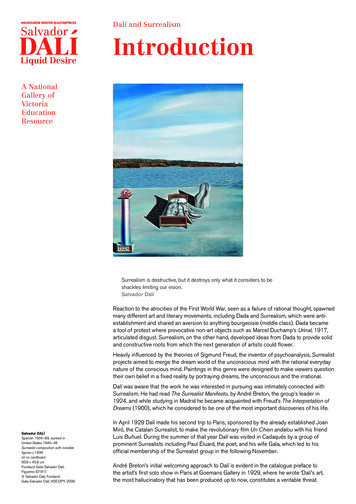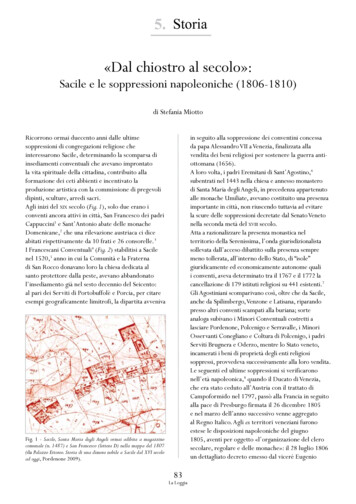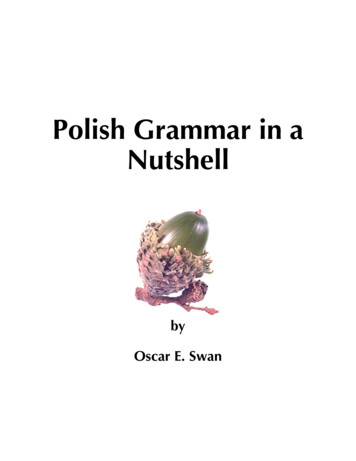
Transcription
Dalí and SurrealismIntroductionA NationalGallery ofVictoriaEducationResourceSurrealism is destructive, but it destroys only what it considers to beshackles limiting our vision.Salvador DalíReaction to the atrocities of the First World War, seen as a failure of rational thought, spawnedmany different art and literary movements, including Dada and Surrealism, which were antiestablishment and shared an aversion to anything bourgeoisie (middle class). Dada becamea tool of protest where provocative non-art objects such as Marcel Duchamp’s Urinal, 1917,articulated disgust. Surrealism, on the other hand, developed ideas from Dada to provide solidand constructive roots from which the next generation of artists could flower.Heavily influenced by the theories of Sigmund Freud, the inventor of psychoanalysis, Surrealistprojects aimed to merge the dream world of the unconscious mind with the rational everydaynature of the conscious mind. Paintings in this genre were designed to make viewers questiontheir own belief in a fixed reality by portraying dreams, the unconscious and the irrational.Dalí was aware that the work he was interested in pursuing was intimately connected withSurrealism. He had read The Surrealist Manifesto, by André Breton, the group’s leader in1924, and while studying in Madrid he became acquainted with Freud’s The Interpretation ofDreams (1900), which he considered to be one of the most important discoveries of his life.Salvador DALÍSpanish 1904–89, worked inUnited States 1940–48Surrealist composition with invisiblefigures c.1936oil on cardboard60.9 x 45.8 cmFundació Gala-Salvador Dalí,Figueres (0191) Salvador Dalí, FundacióGala-Salvador Dalí, VISCOPY, 2009In April 1929 Dalí made his second trip to Paris, sponsored by the already established JoanMiró, the Catalan Surrealist, to make the revolutionary film Un Chien andalou with his friendLuis Buñuel. During the summer of that year Dalí was visited in Cadaqués by a group ofprominent Surrealists including Paul Éluard, the poet, and his wife Gala, which led to hisofficial membership of the Surrealist group in the following November.André Breton’s initial welcoming approach to Dalí is evident in the catalogue preface tothe artist’s first solo show in Paris at Goemans Gallery in 1929, where he wrote ‘Dalí’s art,the most hallucinatory that has been produced up to now, constitutes a veritable threat.
Dalí and SurrealismIntroductionA NationalGallery hes,lobsters,bread,eggs whereDalíniansymbolsAbsolutely new creatures, visibly mal-intentioned, are suddenly on the move’ (André Breton,‘Sterilizer Dalí’, in Salvador Dalí, Camille Goemans Gallery, Paris, 20 November – December1929, trans. in Ian Gibson, The Shameful Life of Salvador Dalí, Faber & Faber, London, 1997,p. 289; quoted in Robert Lubar, Dalí: The Salvador Dalí Museum Collection, Bulfinch Press,Boston, 2000).The beginning of Dalí’s Surrealist period marked a growing confidence in his own style. Theestablishment of the representation of ‘hard’ and ‘soft’, which formed the foundation of hisaesthetic, and the creation of motifs and symbols that became part of his artistic vocabularythroughout his oeuvre, were consolidated at this time. Ants, crutches, keys, watches, lobsters,bread, eggs and other Dalinian symbols were all painted to be interpretable through thelens of Freudian psychology. Leading Dalí scholar, Dawn Ades, has suggested that just asRenaissance artists communicated through the shared language of symbols from the Bible,so Dalí used Freud’s texts in the same manner.In an attempt to unite the Surrealist group, Dalí and André Thirion were commissioned to putforward proposals for a common action that would draw together the threads of the disparatefactions within it.Salvador DALÍSpanish 1904–89, worked inUnited States 1940–48Retrospective bust of a woman1933, reconstructed 1970painted bronze, feathers, plastic, tin74.5 x 67.0 x 28.0 cmFundació Gala-Salvador Dalí,Figueres (5184) Salvador Dalí, Fundació GalaSalvador Dalí, VISCOPY, 2009Dalí proposed the Surreal Object, the magical, transformative concept of the juxtaposition ofdiverse elements usually found in everyday objects. By adding a potent intensity to the idea ofthe ‘found object’, it prompted a new and creative period of Surrealist activity.In Le Surréalisme au service de la revolution, No. 3, December 1931, Dalí describes sixdifferent types of Surrealist Objects, including: symbolically functioning objects such as a shoeand glass of milk; transubstantiated objects such as a soft watch, and machine objects suchas a rocking-chair for thinking (for more detailed information, see Dawn Ades, Dalí, Thames &Hudson, World of Art, 1995, London, p. 152).
Dalí and SurrealismIntroductionA NationalGallery ofVictoriaEducationResourceMay Ray’s Cadeau, 1921, an iron with nails stuck in it; Meret Oppenheimer’s Object, 1936, afur-covered cup and saucer; and Joseph Cornell’s fragments of once beautiful and preciousobjects preserved in boxes during the 1930s are key examples of the classic Surreal Object. even asa child hehad beenintriguedby �s technique for inducing critical-paranoia involves staring fixedly at an object, thenstimulating your visual skills to see something different, like looking at clouds and seeingrecognisable forms. He links this to the mental condition known as paranoia, which involveschronic delusions and hallucinations. He intended to stimulate this trance-like state withoutbecoming a victim of paranoia, as suggested by his well-known statement, ‘The onlydifference between me and a madman is that I am not mad’. His obsession with, and diligencein mastering the process culminated in his popular double image pictures, such as Slavemarket with apparition of the invisible bust of Voltaire, 1940, which can be viewed on this site.The invention of the philosophy known as critical-paranoia was Dalí’s other major contributionto the Surrealist movement. The idea evolved from his life-long fascination with the idea oftransformation – even as a child he had been intrigued by mimetic insects camouflagingthemselves through metamorphosis into sticks and leaves. He studied works by artists whoexperimented with optical illusions, particularly paintings by Giuseppe Arcimboldo (1526–1593), and also acknowledged the influence of Leonardo de Vinci, who had advised his ownstudents to seek inspiration in damp spots and cracks on a wall.Dalí’s relationship with the dour Breton began to sour as he gained increasing commercialsuccess and habitually sprinkled his rhetoric with provocative political and racial statements.When Dalí laid himself open to charges of fascism, it was too much for Breton who challengedhim at the now famous Surrealist meeting in February 1934. Dalí responded to the chargesmade against him, in a mock courtroom situation, by declaring that they were irrelevant to themore important concerns of Surrealism. As he read out his prepared declaration he furtherhumiliated Breton by pretending that he was suffering from a high temperature – with athermometer in his mouth and clad in multiple layers of clothing, he peeled them off one byone in a hilariously irreverent manner.Although Dalí survived the trial and continued to be an influential presence in the movementfor the next five years, he was formally expelled by Breton in 1939. His famous remark that‘the only difference between me and the Surrealists is that I am a Surrealist’ is perhaps ameasure of how little he was affected by the enforced isolation from the group which hadbeen decisively driven by his innovative vision.
Dalí and SurrealismDiscover MoreA NationalGallery ofVictoriaEducationResourceI do not understand why when I ask for a grilled lobster in a restaurant,I am never served a cooked telephone. I do not understand whychampagne is always chilled, and why, on the other hand, telephones,which are habitually so frightfully warm and disagreeably sticky to thetouch, are not also put in silver buckets with crushed ice around them.Salvador Dalí, The Secret Life of Salvador Dalí, Haakon M.Chevalier (trans.), Dial Press, New York, 1942, p. 271The Surreal Object, invented by Dalí and based on the magical, transformative concept ofthe juxtaposition of diverse elements usually found in everyday objects, prompted a new andcreative period of Surrealist activity, particularly as it opened up possibilities for the use of aSurrealist language in the applied and decorative arts.Lobsters and telephones had already made frequent appearances in Dalí’s work for a numberof years, with telephones ‘[haunting] Dalí’s imagery in the dark paintings created in the prewaryears of 1938–39 when they symbolised the British prime minister Neville Chamberlain’sabortive attempts to control Hitler by conversational diplomacy.Salvador DALÍSpanish 1904–89, worked in UnitedStates 1940–48Lobster telephone 1936painted plaster, telephone18.0 x 30.5 x 12.5 cmNational Gallery of Australia,Canberra, Purchased, 1994. Salvador Dalí, Fundació GalaSalvador Dalí, VISCOPY, 2009‘By combining the two objects in 1936, however, Dalí with a single stroke created one of themost memorable sculptures of the twentieth century. The idea apparently came to the artistduring a visit to the home of his English patron Edward James, in June 1936. James, Dalí andother friends were eating lobsters and tossing aside their shells, when one happened to landon the telephone (Sharon Michi-Kusunoki, ‘Lobster Telephone’, in Dawn Ades (ed.), Dalí: TheCentenary Retrospective, Thames & Hudson, London, 2004, p. 286). Dalí loved shellfish fortheir contrast of a hard protective shell with soft living centre, and saw an analogy perhapswith the telephone, where soft human sounds are transmitted across hard receivers ‘James ordered the production of ten functioning telephones with attached crustaceans, fourwith red lobsters on black phones and six with white lobsters on white phones’ (Ted Gott,Salvador Dalí: Liquid Desire, National Gallery of Victoria, 2009, p. 145).’
Dalí and SurrealismDiscover MoreA NationalGallery ofVictoriaEducationResourceSlave market with apparition of the invisible bust of Voltaire exemplifies the calibre of Dalí’spainting during this period. It is one of the finest examples of his double imagery, an opticalillusion in which individual recognisable forms can alternately be seen as other objects.Created by the artist using his paranoiac-critical method, which involves staring at an objectuntil your visual skills transform it into something else, the work questions the meaning ofreality, perception, and rational and irrational thought.Dalí has painted a shadowy, serene portrait of Gala as a semi-nude slave girl surveying thestrange scene before her. Depending on the viewer’s perception the eye is led to the headof Voltaire, modelled on the celebrated bust of 1778 by Jean-Antoine Houdon, or two Dutchwomen standing in the marketplace. The top of Voltaire’s head is outlined by the archway inthe decaying wall and aspects of the women form his eyes, nose, chin and neck. Dual imagesalso appear in the Catalan landscape on the far right of the painting – the dark, gently slopinghill becomes a pear sitting in a fruit bowl, thus incorporating parts of the background andforeground. Similarly, a plum sitting to the left of the pear also transforms into the buttocks ofa man standing behind the bowl.Voltaire was a French Enlightenment philosopher whom Dalí had read about as a young man.In his book, The Unspeakable Confessions of Salvador Dalí (Quill, New York, 1981), Dalí says:‘The illustrious Monsieur de Voltaire possessed a peculiar kind of thought that was the mostrefined, most rational, most sterile, and misguided not only in France but in the entire world’.Salvador DALÍSpanish 1904–89, worked in UnitedStates 1940–48Slave market with apparition of theinvisible bust of Voltaire 1940oil on canvas46.4 x 62.9 cmThe Salvador Dalí Museum, StPetersburg, FloridaWorldwide Rights: SalvadorDalí, Fundació Gala-Salvador Dalí,VISCOPY, 2009In the USA: Salvador Dalí MuseumInc., St Petersburg, FL, 2009The world of the painter was the antithesis of Voltaire’s emphasis on rational thought andorder, and Dalí has suggested that this image of Gala, his devoted muse, is a symbol that herpresence in his life has protected him from Voltaire and the sceptical thought he espoused.Dalí, whose passion for science was increasingly evident in his later oeuvre, must have beendelighted when the December 1971 issue of the Scientific American magazine featured adetail from this painting to demonstrate the physical structure of the perception system ofsight, in which the optical neurons reverse the images that can both be seen, although notsimultaneously.
Dalí and SurrealismA NationalGallery ofVictoriaEducationResource toresearchthe strangepaintingsof GiuseppeArcimboldo(1527–1593).Dalí under themicroscopeLooking and discussing Describe all the things you can see in the painting. Which stand out more and why? Dalí used his technique of critical-paranoia to create this image containing double imagery.He stared intensely at an object until he saw a different image, just as we sometimes look atclouds and see recognisable forms. D escribe where you can see double images occurring in the painting. Which single word would you use to describe the atmosphere? Explain which particular art elements, such as form, colour, line and so on, have been mostimportant in creating a sense of mood and drama? What aspects of the painting do you find most interesting and why? If you could add something to the painting, what would it be? What questions would you like to ask Dalí about this picture?ResearchingSalvador DALÍSpanish 1904–89, worked in UnitedStates 1940–48Slave market with apparition of theinvisible bust of Voltaire 1940oil on canvas46.4 x 62.9 cmThe Salvador Dalí Museum, StPetersburg, FloridaWorldwide Rights: SalvadorDalí, Fundació Gala-Salvador Dalí,VISCOPY, 2009In the USA: Salvador Dalí MuseumInc., St Petersburg, FL, 2009 Use books and the internet to research the strange paintings of Giuseppe Arcimboldo(1527–1593), who combined images of fruit and vegetables to create human faces. Whymight Dalí have been influenced by him? L ocate and discuss works by the following artists who also interested Dalí because of theirinterest in optical illusions: M. C. Escher (1898–1972) and Bridget Riley (1931– ). L ocate The hallucinogenic toreador (1969–1970) and Gala contemplating the MediterraneanSea which at twenty meters becomes the portrait of Abraham Lincoln – Homage to Rothko(second version) (1976) on the Salvador Dalí Museum website: www.salvadordalimuseum.org or in books. Discuss the double imagery you can see in each case.
Dalí and SurrealismA NationalGallery njuxtapositionDalí under themicroscopeWhat is Surrealism?In 1929 Dalí was accepted in a group called the Surrealists. Thisgroup was formed by artists and writers who were disappointed withtheir society and those who were ruling at that time. The Surrealistswere from all over the world, but they mainly lived and worked in Paris,France, where they discussed new ideas. The Surrealists did not like thepopular art of the time and their goal was to make art that would shockpeople and force them to think rather than just look at art. They wereparticularly upset with the horrors of World War One. They felt that if therational mind (the mind you think with) had created the society they didnot like, then perhaps the unconscious mind (the mind you glimpse onthe verge of sleep or in your dreams) could build a better world. So theywere looking into their unconscious and into their dreams for inspiration.Some of the special techniques the Surrealist painters used involvedchallenging people’s ideas of reality. Sometimes the artists would usemetamorphosis, which is morphing or changing an object or person intosomething else. In one painting Dalí morphed one of his favourite artistsinto a table. Dislocation was another technique they used. This meansputting something where you wouldn’t expect to see it, like red lipsfloating in the sky. A third technique they used was juxtaposition, placingtwo things side by side that don’t usually go together, like a donkey ontop of a piano.Dalí Times St. Petersburg Times 2007, Newspaper in Education. Read and discuss the text above. Choose one of Dalí’s works on this site or locate otherfamous works by the artist. Study the picture carefully. Find and describe examples ofwhere Dalí has used metamorphosis, dislocation and juxtaposition. Cut out a collection of images from magazines. Create a surreal collage whichdemonstrates metamorphosis, dislocation and juxtaposition.Salvador DALÍSpanish 1904–89, worked in UnitedStates 1940–48Lobster telephone 1936painted plaster, telephone18.0 x 30.5 x 12.5 cmNational Gallery of Australia,Canberra, Purchased, 1994. Salvador Dalí, Fundació GalaSalvador Dalí, VISCOPY, 2009 D escribe and discuss the Lobster telephone, 1936. What aspects make this objectinteresting and bizarre? Why might Dalí have been attracted to a lobster? How manyopposites can you see occurring, such as natural/man-made? Write your own definition of the Surreal Object for an art dictionary. Dalí created a list of rules that described the Surreal Object. Invent your own list of crazyrules for making one. Give it to a friend and ask them to draw or construct a Surreal Objectwhich follows your rules.
Dalí and SurrealismA NationalGallery ofVictoriaEducationResourceDalí under themicroscopeDalí inventedhis own‘alphabet’of symbolsto expressideas andconcepts.SymbolismA symbol is a representation of an idea, for example, a heart can symbolise love and a dove,peace. Dalí invented his own ‘alphabet’ of symbols to express ideas and concepts. Look outfor his most common symbols listed below to help you interpret his works. Ants – death and decay. Crutch – several meanings, including support for inadequacy in life, tradition anddeath. Melting clocks – the relative nature of time. Grasshoppers – irrational fear.Salvador DALÍSpanish 1904–89, worked in UnitedStates 1940–48Surrealist composition (c. 1928)oil, sand and collage on wood79.7 x 38.3 cmFundació Gala-Salvador Dalí,Figueres (0027) Salvador Dalí, Fundació GalaSalvador Dalí, VISCOPY, 2009Salvador DALÍSpanish 1904–89, worked in UnitedStates 1940–48Memory of the child-woman 1932oil on canvas99.1 x 120.0 cmThe Salvador Dalí Museum, StPetersburg, FloridaWorldwide Rights: SalvadorDalí, Fundació Gala-Salvador Dalí,VISCOPY, 2009In the USA: Salvador Dalí MuseumInc., St Petersburg, FL, 2009 Flies – decay and symbol of his homeland, Spain. Eggs – Memories of the time before he was born. Keys – tools to unlock dreams. Locate and discuss work by other artists who have used symbolism. Consider what symbols you might invent to convey ideas of your own in an artwork.
Dalí and SurrealismA NationalGallery ofVictoriaEducationResourceDalí under themicroscopeI do not understand why when I ask for a grilled lobster in a restaurant,I am never served a cooked telephone. I do not understand whychampagne is always chilled, and why, on the other hand, telephones,which are habitually so frightfully warm and disagreeably sticky to thetouch, are not also put in silver buckets with crushed ice around them. I do not understand why no one invents taxi-cabs more expensivethan the others fitted with a device for making artificial rain which wouldoblige the passenger to wear his rain coat when he got in while theweather was fine and sunny outside.The Secret Life of Salvador Dalí, Haakon M. Chevalier (trans.), DialPress, New York, 1942, p. 271.Why mightsurrealismbe usedfrequently inadvertising? R ead and discuss the two quotations above. Write your own quirky surreal paragraph,beginning with: ‘I do not understand why ’ Why might surrealism be used frequently in advertising? Discuss examples in today’s worldthat utilise surrealism.Surrealist fun!The Surrealists used a number of games and activities to try to let go of their rationalconscious mind and access their unconscious mind. Try the following activities to inspireyour own surrealist writing and art-making.Automatic writing and drawing W rite down everything that comes into your mind as quickly as possible without lifting yourpen from your paper for a few minutes. What strange ideas have emerged from your innermind? Carry out the same process, but this time draw instead. Can you find any hidden shapes orfigures?The association gameIn pairs, one person calls out the name of an object. The other person responds by saying thefirst item that comes into their mind when they think of this object. What strange combinationshave emerged?
Dalí and SurrealismA NationalGallery ofVictoriaEducationResourceDalí under themicroscopeExquisite corpse Decide on a sentence structure such as: Article, adjective Noun Verb Article, adjective Noun Provide everyone in a small group with pencil and paper. Each person in the group writes down the first words of the structure, folds over the paperand passes it on to the next person. The process continues until the structure is finished. The paper is unfolded to reveal asurrealist sentence. Note: Depending on the verb used it may sometimes be necessary toadd a preposition to ensure the sentence flows smoothly. The game gets its name from thesentence created when it was first played: The exquisite corpse will drink the young wine.The game can also be played by substituting the words for drawings of parts of a human oranimal body.Random word playFind a short article in a newspaper or magazine. Cut out each of the words and place themin a bag. Shake the bag and then scatter the words onto a flat surface. Try to find bizarrephrases and sentences in the random arrangement of words.CreatingPoster design D esign a poster that would particularly attract young people to a Salvador Dalíretrospective exhibition being held in a public gallery. C reate a title for the exhibition that would be integrated into the design. Consider usingimages from this site or photographs of Dalí and/or his work gathered from the internet. Using your own drawing skills or a computer program such as Photoshop, illustrate howyour poster would look in situ; for example, on a billboard in a city, on a café window oron a tram.
Dalí and SurrealismA NationalGallery ofVictoriaEducationResourceDalí under themicroscopeA Dalí didactic panel Didactic panels are sometimes placed on the walls of public art galleries to provideinformation and insights about works of art. They are written by curators with specialist artknowledge. S tudy the two didactic panels below. You can find images of In praise of dialectics, 1937,and Weeping woman, 1937, on the NGV website.René MagritteBelgian 1898–1967In praise of dialecticsL’élogue de la dialectique1937oil on canvasFelton Bequest, 1971 Rene Magritte/ADAGP, Paris.Licensed by VISCOPY, AustraliaDidacticpanelsprovideinformationand insightsabout worksof art.With their strange juxtapositions and memorable images, the paintings of René Magritte arebased upon the conviction that depictions of mental ideas are as valid as the recording ofexternal events. Few artists have given us so many clear depictions of the life of the inner self.In making the familiar so unfamiliar, however, Magritte also stops us short and reminds us oflife as lived in the mind.Pablo PicassoSpanish 1881–1973worked in France 1904–73Weeping woman1937oil on canvasPurchased by donors of The Art Foundation of Victoria,with the assistance of the Jack and Genia Liberman family,Founder Benefactor, 1986. Pablo Picasso/Sussession Pablo Picasso.Licensed by VISCOPY, AustraliaIn January 1937, Picasso had been asked by representatives of the Spanish Republicangovernment to paint an enormous mural for the Spanish Pavilion at the Paris InternationalExhibition in the coming summer. On 26 April 1937, while Picasso was at work on thecommission, German planes – acting in concert with General Franco – bombed the Basquecity of Guernica for three hours, levelling it to the ground. Picasso’s shock at the massacre ofSpanish civilians contributed to his creation of the great Guernica mural.The Weeping women compositions of late 1937 belong to what have been termed the‘postscripts’ of Guernica. The common stark motif in these disturbing images, that of awoman’s grief laid bare for public scrutiny, derived from the figure at the far left of Guernica– a woman who screams uncontrollably and attempts vainly to escape the bombing, graspingher dead child to her chest.Aspects of Picasso’s turbulent love life have also been read into Weeping woman – a complexweb of relationships involving his first wife Olga Koklova and concurrent new lovers, MarieThérèse Walter and Dora Maar.
Dalí and SurrealismA NationalGallery ofVictoriaEducationResourceDalí under themicroscope R ead the texts on this site about Dalí‘s Lobster telephone, 1936, and Slave market withapparition of the invisible bust of Voltaire, 1940. C hoose one of them and write a didactic panel that will help viewers to learn more aboutthe work.‘The onlydifferencebetweenme and amadman isthat I’mnot mad’?The bigger picture – Thinking beyond ‘Surrealism is destructive, but it destroys only what it considers to be shackles limiting ourvision’ – Salvador Dalí. D iscuss the meaning of the quotation above. In what ways does Dalí challenge ourperceptions of what is real and unreal? D iscuss what Dalí might have meant by the quotation ‘The only difference between meand a madman is that I’m not mad’? W hat is beauty in art? Can ugliness ever be beautiful? If so, in what circumstances? ‘Beautiful as the chance encounter of a sewing machine and an umbrella on a dissectiontable’ – Le Comte de Lautréamont, Les Chants de Maldoror. E xplain why might Le Comte de Lautréamont, the writer of the quotation above, who greatlyinfluenced the Surrealists, have found the combination of images he describes beautiful? Some people in the past were shocked and offended by some of the graphic imagery inDalí’s work. George Orwell, the famous writer of Nineteen Eighty-Four, published in 1949,wrote an essay strongly condemning what he regarded as the obscene nature of the artist’swork. Discuss whether there is ever a case for censorship in art?
Salvador Dalí, The Secret Life of Salvador Dalí, Haakon M. Chevalier (trans.), Dial Press, New York, 1942, p. 271 The Surreal Object, invented by Dalí and based on the magical, transformative concept of










